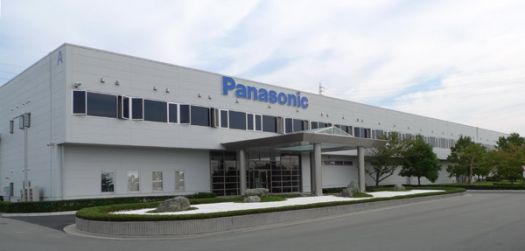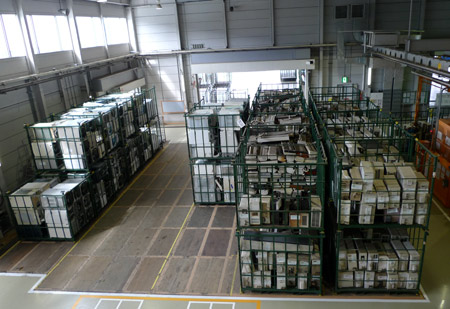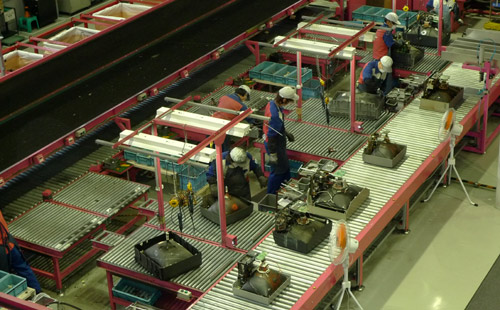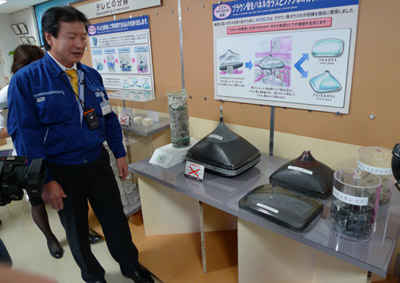On a recent trip to Japan for CEATEC 2008, I was able to take a short side trip to Osaka (well, short trip on the Shinkansen bullet train, which currently travels at over 180 miles per hour, but I digress). On this side trip I was fortunate enough to visit the Panasonic Eco Technology Center (PETEC) in Kato City (Hyogo Prefecture). The purpose of the PETEC plant is to collect and recycle consumer electronics and appliances that have reached the end of their useful life.
Based on current Japanese law, consumers are required to
recycle air conditioners, refrigerators, washing machines and CRT (tube)
televisions. The consumer pays a recycling fee to cover transportation of the old appliance to the nearest
recycling center and the cost of recycling itself. PETEC is one such
center: a recycling plant that processes over 700,000 individual appliances
each and every year. Rather than ending
up as landfill, these appliances are broken down into their raw materials --
partially by man, partially by machine -- to be reused as building materials, as outdoor furniture and
as raw materials for the next generation of consumer appliances.

At PETEC, a loading area features endless stacks of pallets, each piled with broken down old appliances awaiting the process that will give them new life as components of new appliances. Specialized assembly lines have trained workers peeling apart the various pieces of these appliances: the copper cooling tubes in an air conditioner, the cast iron compressor of a refrigerator, the leaded glass tube of a CRT TV, the mostly copper wiring harnesses inside a washing machine. These parts are then separated and sorted so that like materials can be grouped together.

The remainder of this rough separation process -- the hulking metal and plastic shell of a refrigerator, washing machine or air conditioner -- is then fed to the shredder: a massive grinding tool in a sealed compartment with hardened steel gears that rip apart a full sized appliance in a matter of seconds. What's left is a collection of metal and plastic pieces each about the size of a small peanut.
The peanut-sized pieces are then separated via a series of
different processes: water is used to separate the lighter plastic from the
rest, then a strong magnetic sorting device is used to separate the metals from the
residual plastics and non-ferrous metals, and then a final vibrating platform is used to separate the
different types of metal from each other (aluminum vs. iron vs. copper). Panasonic says this process allows them to
recycle up to 90% of the full weight of the appliance in reusable materials and
to recover copper and iron with 99.8% purity.

Watching the process at work is a fascinating study of efficiency through trained personnel and specialized technology. But what may be most surprising is that this environmentally friendly operation is actually profitable: the cost of operation is exceeded by the value of the materials recovered. So the benefits carry through across the board: the environment is served by reducing the amount of dangerous materials dumped into landfills; local workers are employed in the plant's operation; and Panasonic gets less expensive raw materials to build the next generation of consumer appliances. As Panasonic says, these end-of-life appliances are the "ore veins of the 21st century" and they allow a country like Japan, naturally poor in raw materials, to become more self-sufficient in their production processes.
Engineers at PETEC collaborate with new product design engineers to make new appliances more recycling-friendly with fewer parts that are easier to disassemble without sacrificing structural or mechanical integrity. This will allows Panasonic to waste even less materials in the future when these greener products finally reach the end of their useful lives.

Why some enterprising U.S. companies have not come on-board with similar plants is a bit puzzling. There are a handful of private initiatives, such as a partnership between Clover Technologies Group and the US post office to recycle small portable electronics devices. Some local and state laws are beginning to take hold in states such as California and New York (for some appliances), and it has already become illegal to dump old CRT televisions in landfills in many cities and towns across the country, due to the high content of toxic lead in the CRT glass. But there is currently no national legislation or program to provide a viable alternative to throwing that old TV set or refrigerator away.
Ultimately it comes down to the current federal government administration's hands-off policy when it comes to business and to environmentally responsible legislation. Whatever the cause, it's clear we've got a long way to go if we want to catch up with Japan when it comes to going green.
More Information: